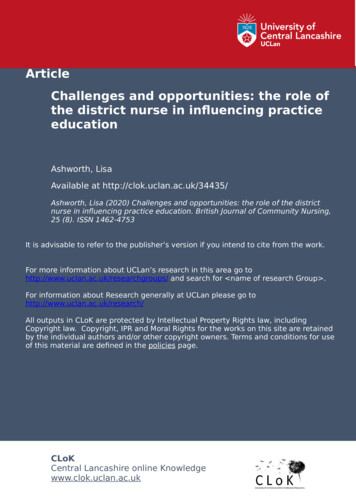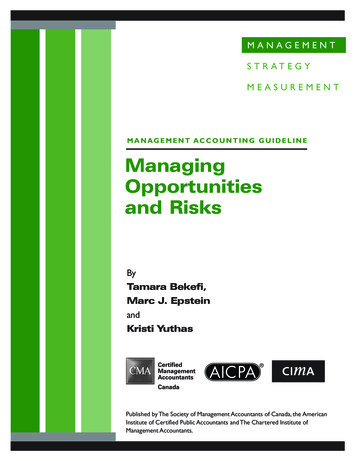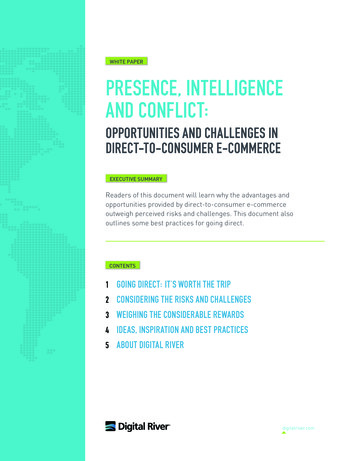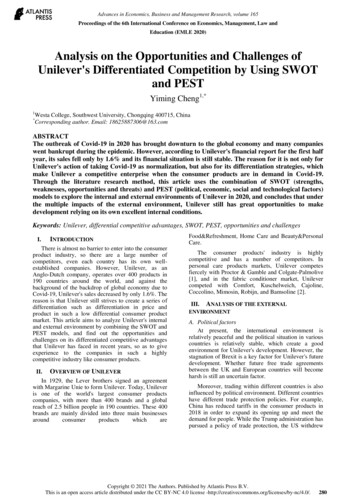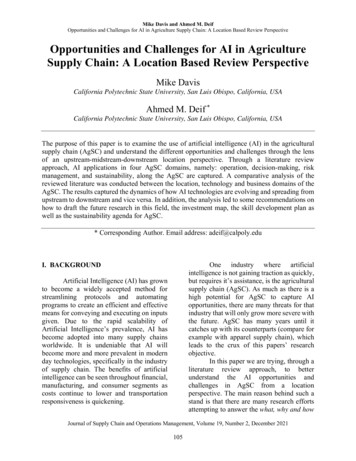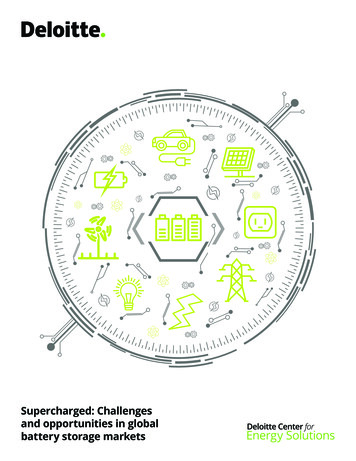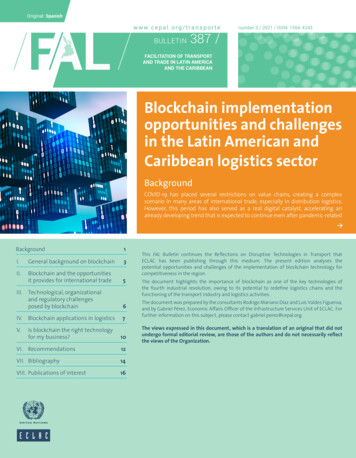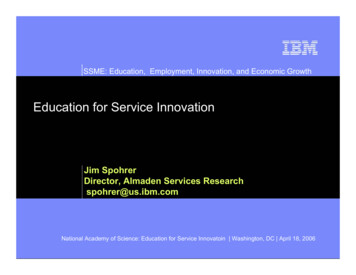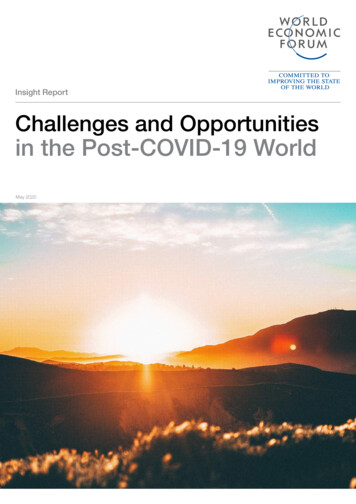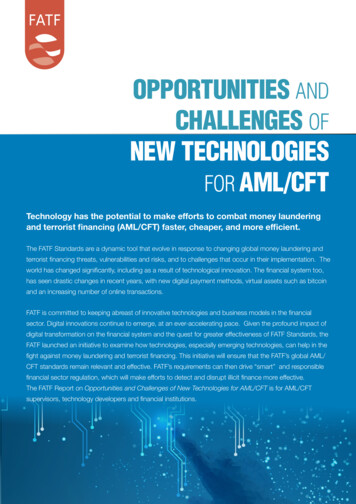
Transcription
OPPORTUNITIES ANDCHALLENGES OFNEW TECHNOLOGIESFOR AML/CFTTechnology has the potential to make efforts to combat money launderingand terrorist financing (AML/CFT) faster, cheaper, and more efficient.The FATF Standards are a dynamic tool that evolve in response to changing global money laundering andterrorist financing threats, vulnerabilities and risks, and to challenges that occur in their implementation. Theworld has changed significantly, including as a result of technological innovation. The financial system too,has seen drastic changes in recent years, with new digital payment methods, virtual assets such as bitcoinand an increasing number of online transactions.FATF is committed to keeping abreast of innovative technologies and business models in the financialsector. Digital innovations continue to emerge, at an ever-accelerating pace. Given the profound impact ofdigital transformation on the financial system and the quest for greater effectiveness of FATF Standards, theFATF launched an initiative to examine how technologies, especially emerging technologies, can help in thefight against money laundering and terrorist financing. This initiative will ensure that the FATF’s global AML/CFT standards remain relevant and effective. FATF’s requirements can then drive “smart” and responsiblefinancial sector regulation, which will make efforts to detect and disrupt illicit finance more effective.The FATF Report on Opportunities and Challenges of New Technologies for AML/CFT is for AML/CFTsupervisors, technology developers and financial institutions.
OPPORTUNITIES AND CHALLENGES OF NEW TECHNOLOGIES FOR AML/CFTHOW CAN TECHNOLOGY IMPROVE IMPLEMENTATION OFTHE FATF RECOMMENDATIONS?IMPLEMENTING THE RISK-BASED APPROACH.The risk-based approach is the cornerstone of the FATF Standards. It requires public and private sector tounderstand fully the money laundering and terrorist financing risks they face, and take appropriate actionto address these risks. Nevertheless, FATF’s country assessments show that some countries still find itchallenging to apply the risk-based approach. In some countries, banks and other regulated entities still relyon a rules-based approach, which is one of the contributing factors for defensive and over-reporting.Technology can increase the capacity to collect and process data, and share it with stakeholders, includingsupervisors. Artificial intelligence-based tools can analyse data accurately, in real-time and help better identifyemerging risks. It can also assist the validation of the results of manual assessments, and their subsequentconclusions.FINANCIAL INCLUSIONAround the world, one billion people struggle to provide adequate identification documents for opening bankaccounts or maintaining access to financial servicesInnovative technology-based solutions, such as digital ID, may contribute to financial inclusion, as longas they are implemented through a responsible and risk-based approach. They can provide solutions todisadvantaged or otherwise excluded societal groups and facilitate access to traditional financial products orservices. Technology can minimise weaknesses in human control measures, improve customer experience,generate cost savings, and facilitate transaction monitoring. Any adoption of new technologies for AML/CFTpurposes must follow a problem-solving approach, which does not create an additional burden or unintendedconsequences. This includes unintentionally exacerbating financial exclusion, for example, in sectors of thepopulation that do not have access to electronic devices.Download the reportOPPORTUNITIES ANDCHALLENGES OF NEWTECHNOLOGIES FOR AML/CFTJULY 2021Opportunities and Challenges of New Technologies forAML/CFT, July 2021, from www.fatf-gafi.org
OPPORTUNITIES AND CHALLENGES OF NEW TECHNOLOGIES FOR AML/CFTHOW CAN NEW TECHNOLOGIES IMPROVE ANTI-MONEYLAUNDERING AND COUNTER-TERRORIST FINANCINGACTION?Technology has the potential to make efforts to combat money laundering and terrorist financing faster,cheaper, and more efficient. It can process large volumes of information that go beyond human capability andprovide data processing results in record time, releasing human resources for more critical work such as thePRIVATE SECTORanalysis of complex ML/TF cases.Multinational financial institutions, retail and commercial banks andinternet-based firms such as Fintech take the lead when it comesto implementing new technologies. The advantages for the privatesector include:Diligence - can streamline on-boardingprocesses by adapting to the risk,context and individual. In particular,Better identification, understanding and management ofML/TF risksmixed approaches, where official ID’sProcess and analyse larger sets of data faster and moreaccuratelyidentification may offer more robust Efficient digital on-boardingbeen widely adopted and supported in Greater auditability, accountability and overall goodgovernancemany jurisdictions. The enhanced useReduce costs and maximise human resources to morecomplex areas of AML/CFTand matching could also improveImprove the quality of suspicious activity reportsubmissionsaccurate and up-to-date collection and SUPERVISORSDigital Solutions for Customer Dueare provided in tandem with biometricidentification processes. Digital ID hasof technologies for client screeningefficiency as these tools allow for moreprocessing.Technology can also improve supervision through better live monitoring, exchange of information withcounterparts, and a more informed oversight of regulated entities. The advantages for the supervisorsinclude: Supervise a larger number of entities Better identify and understand the risks associated to the different sectors individual entities Live monitor compliance with AML/CFT standards and act in cases of non-compliance Communicate more efficiently with regulated entities and carry out additional informationrequests Store, process and report on larger sets of supervisory data Exchange information with other competent authorities
OPPORTUNITIES AND CHALLENGES OF NEW TECHNOLOGIES FOR AML/CFTWHICH TECHNOLOGIES OFFER THEMOST POTENTIAL TO AML/CFT?MACHINE LEARNINGoffers the greatest advantage through its ability to learn fromexisting systems, reducing the need for manual input into monitoring, reducing falsepositives and identifying complex cases, as well as facilitating risk management. The mostuseful applications of Machine Learning to AML/CFT include:Identification and Verification of customers through authentication AI, includingbiometrics, and liveness detection techniques (micro expression analysis, anti-spoofingchecks, fake image detection, and human face attributes analysis)Monitoring of the business relationship and behavioural and transactional analysis byusing Machine Learning algorithms to place customers with similar behaviour intocohesive groupings to monitor and alert scorings to focus on patterns of activityIdentification and implementation of regulatory updates: Machine Learning techniquescan scan and interpret big volumes of unstructured regulatory data sources on anongoing basis to automatically identify, analyse and then shortlist it based on theinstitutions’ requirements.Automated data reporting (ADR) can make granular data available in bulk tosupervisors.DISTRIBUTED LEDGER TECHNOLOGY (DLT) may improve traceability of transactionson a cross-border basis, and even global scale, making identity verification easier. It mayspeed up the customer due diligence process, as consumers can authenticate themselves.They can even be automatically approved or denied through smart contracts that verify thedata.DLT continue to pose challenges from an AML/CFT perspective as they are decentralized innature and enable un-intermediated peer-to-peer transactions without any scrutiny.
OPPORTUNITIES AND CHALLENGES OF NEW TECHNOLOGIES FOR AML/CFTNATURAL LANGUAGE PROCESSING AND SOFT COMPUTING TECHNIQUESsimulates human decision-making, as a result, it can take incomplete, ambiguous,distorted, or inaccurate (fuzzy) input and produce useful outputs. Like with all technologicalsolutions, when they are integrated with broader monitoring systems, they should includean element of human analysis for specific alerts or areas of higher risk.Application Programming Interfaces (APIs)connect customer identificationsoftware with monitoring tools, or risk and threats identification tools with customer riskprofiles. An API will generate alerts or alter risk classifications as relevant. This can:Improve the interoperability between traditional banking data, moving away from siloedsystems with fragmented frameworks.Increase automation and optimise resources and output accuracy.Supply an aggregated and normalized data feed, helping to build a more complete riskprofile for new customers.Does the FATF validate or recommend any particular tools?The FATF does not validate, contribute or in any way get involved in the development of technologies.The FATF does not take a position on individual technologies or providers.See alsoStocktake on Data Pooling, Collaborative Analytics andSTOCKTAKE ON DATA POOLING,COLLABORATIVE ANALYTICSAND DATA PROTECTIONJULY 2021Data Protection, July 2021, from www.fatf-gafi.org
OPPORTUNITIES AND CHALLENGES OF NEW TECHNOLOGIES FOR AML/CFTWHAT ARE THE CHALLENGES IN IMPLEMENTINGNEW TECHNOLOGIES FOR AML/CFT?Adoption and demand for new technologies has been unequal. There are significant gaps betweenlarge financial institutions and smaller stakeholders, but also at a regional and national level, with somecountries falling behind in digital innovation. What are the particular challenges that are holding backimplementation of new technologies?Regulatory obstacles – are one of the main challenges to the use of technology for AML/CFT.Some supervisors are still at the early stages of developing expertise and resourcesto properly understand and supervise new technologies. Even when supervisors dounderstand the interpretability and explainability of new technologies, the regulatorypractices still need to be adjusted to the conditions of new AML/CFT technologies.Technology will not improve effectiveness without accurate and high quality data. Theoptimal use of new technologies for AML/CFT relies on data that is easier for technologydevelopers to integrate into their tools, easy to understand and explain to non-experts, andeasy to communicate to counterparts and competent authorities when needed. Ensuring dataquality is also essential to the adoption of AML/CFT technology-based solutions.Operational challenges – relate mostly to adapting practices to new technologies. Developingand implementing new technologies requires a significant investment. It often meansreplacing legacy systems with the new tools. And investing in developing the necessaryskills to understand the technology and to train additional staff.Replacing or updating legacy systems can be complex and expensive. This makesit challenging for both industry and government to exploit the potential of innovativeapproaches to AML/CFT. For industry, the cost-benefit analysis stemming from a lackof regulatory incentives, whether real or perceived, continues to pose an obstacle to agreater uptake of innovative solutions for AML/CFT. Difficulties with the explainability andinterpretability of digital solutions are another key challenge for both industry and regulators. Inpart, this can be due to the limited availability of relevant expertise and some lack of awarenessof innovative technologies’ potential among AML/CFT professionals, both in industry andgovernment.
OPPORTUNITIES AND CHALLENGES OF NEW TECHNOLOGIES FOR AML/CFTThe unintended consequences of new technologies – such as ethical and legal issues, can arisefrom a misguided implementation of these tools.New technologies must be adopted in a responsible, proportionate and risk-basedapproach manner, which maximises effectiveness gains whilst ensuring financialinclusion and the protection of underserved populations, data protection and privacy.Operational risks and risk mitigants of new technologies, including unintendedexclusion and privacy risks, are discussed in FATF’s Guidance on Digital Identity.How can we addressthese risks andbenefit from theadvantages thattechnology can offer?Industry must continuously examine the effectiveness of these newtechnologies to detect and combat ML/TF risks, as well as theirrelation to emerging risks or any unintended consequences. Bothpublic and private sector should re-calibrate their technologybased solutions, if they do not fulfill the intended purpose. It isalso essential to ensure that there is no over-reliance on newtechnologies. Human input and capacity building also continue tobe essential, in particular regarding elements that technology stillcannot overcome, regional inequalities or expertise on emergingissues.See alsoDigital Identity, FATF Guidance, February 2020,DIGITAL IDENTITYMARCH 2020from www.fatf-gafi.org
OPPORTUNITIES AND CHALLENGES OF NEW TECHNOLOGIES FOR AML/CFTHOW CAN WE CREATE AN ENVIRONMENT THATENCOURAGES AND ENABLESNEW TECHNOLOGIES IN AML/CFTThe opportunities and challenges of using new technologies forAML/CFT rely on regulatory and policy responses as well as ontechnological development.Some countries and mostly large financial institutions or bankshave already begun adopting and using new technologies aspart of regular compliance efforts.However, for digital innovation to reach its full potential ofmaking global AML/CFT efforts more effective, it needs to beadopted in scale and by the majority of stakeholders around theglobe.Supervisors should take a proactive approach to technology.This would help address some of the outstanding risk and trustconcerns that some banks or other private sector entities have.Tech-sprints, accelerators, innovation hubs, and othercollaborative initiatives can allow the private sector to develop,present, and test its tools. It can also receive feedback on howsuch tools apply to the AML/CFT frameworks.FATF encourages countries to work together and withthe private sector to consider a holistic approach to newtechnologies, taking into account its potential as well as itslimitations.The adoption and implementation of new technologies mustreflect threats as well as opportunities, and ensure its use iscompatible with international standards of data protection andprivacy, and cybersecurity.
generate cost savings, and facilitate transaction monitoring. Any adoption of new technologies for AML/CFT purposes must follow a problem-solving approach, which does not create an additional burden or unintended consequences. This includes unintentionally exacerbating financial exclusion, for example, in sectors of the
